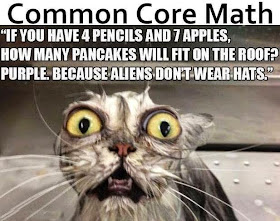My preservice teachers have reached stage four, Sequencing, of the Five Practices (see previous posts for Anticipating, Monitoring, and Selecting). Because these teachers have no direct experience facilitating a discussion involving students reflecting on their mathematical thinking, we return to the third-grade class and watch a video of how the teacher Sequences the work of the students on the turkey-cost problem. I ask the future educators to watch the consolidating conversation and hypothesize why the teacher decided to order the student-work the way she did.
=====
 |
| All images are from New Perspectives on Learning used with the permission of the authors |

Emma and Emma take the $1.25/pound price and start with a friendlier number - $1 per pound. If that were the price, then the 24 pound turkey would cost $24. But they recognize they need another twenty-four $0.25 to find the total costs. So they count by 25s, keeping track of how many 25s they have counted underneath. They find they need another $6 for a total cost of $30.
 Harry and Ese use a similar strategy of breaking the price per pound into a dollar and a quarter. However, instead of counting by 25s, they gather the quarters in groups of four. Each group of four quarters is a dollar. There are six groups. Therefore, $6 must be added to $24 to get the total cost of $30.
Harry and Ese use a similar strategy of breaking the price per pound into a dollar and a quarter. However, instead of counting by 25s, they gather the quarters in groups of four. Each group of four quarters is a dollar. There are six groups. Therefore, $6 must be added to $24 to get the total cost of $30. The next pair, Nellie and Nate, also start by taking off the 25 cents to get an initial cost of $24. Then they group the quarters, but they do it differently than Harry and Ese. Instead of showing "pictures" of quarters, they use a table to represent the relationship between pounds and dollars at $0.25 per pound. The table shows that 24 pounds requires an extra $6. Again, the total cost is $30.
The next pair, Nellie and Nate, also start by taking off the 25 cents to get an initial cost of $24. Then they group the quarters, but they do it differently than Harry and Ese. Instead of showing "pictures" of quarters, they use a table to represent the relationship between pounds and dollars at $0.25 per pound. The table shows that 24 pounds requires an extra $6. Again, the total cost is $30.
Finally, Suzanne and Rose share a unique strategy that does not break up the $1.25. They know that "4 pounds is 5.00" and use this to jump by 5s on the open number line. There are six jumps because there are six 4s in 24 pounds. Although they use a different approach, Suzanne and Rose also find the cost to be "30 $ in all!"
=====
After observing the Sequence of approaches, the preservice teachers offer their hypotheses about why the teacher put the student-work in this particular order. Some suggest it might have progressed from "most popular" to "most unique." Others think it was based on increasingly sophisticated structures. A few wonder if it might be related to the different representations being used.
Why do you think the teacher ordered the work in this way? And where do you think the teacher goes next to complete the last Five Practices stage, Connecting? As always, your participation in the comments is appreciated.










